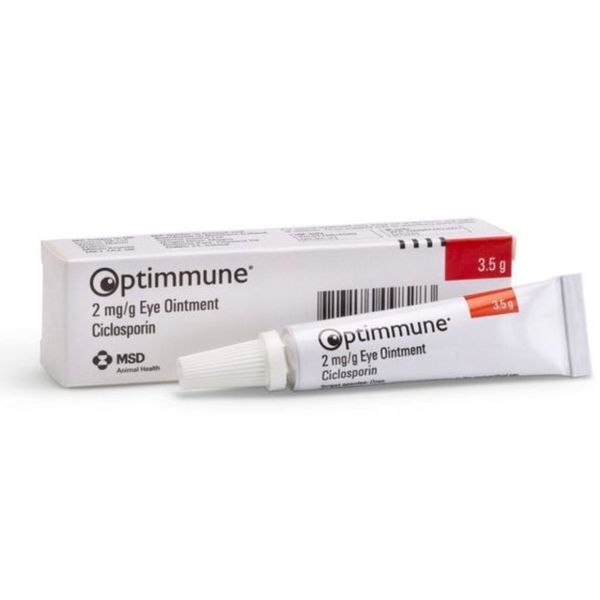|
Quantity
|
Out of stock
|
||
|
|
|||
🐕 OPTIMMUNE OINTMENT 🐕
1 g of the drug contains: CYCLOSPORINE A - 2 mg
🚑 Restores natural tear production.
Treatment of chronic idiopathic keratoconjunctivitis sicca (KCS), and chronic superficial keratitis (CSK) in dogs. Cyclosporine A is an immunosuppressive drug that affects cells present in lymphocytic infiltrates of the lacrimal glands. Through this action, it restores the impaired secretory function of these glands, thus ensuring the secretion of the tear film in the case of keratoconjunctivitis sicca (KCS).
🟢 Doses and method of use:
Before applying the drug (ointment), wash and thoroughly clean the affected eye. The ointment in an amount of 1/2-1 cm should be applied directly to the cornea or conjunctival sac every 12 hours, so that the tip of the tube does not touch the surface of the eye. An increase in tear fluid production should be expected within 10 days of starting treatment with the drug. Maximum tear production can be expected for up to 6 weeks.
The Schirmer test can be used to assess the effectiveness of therapy in the treatment of sicca keratoconjunctivitis. The Schirmer test should be performed 3 hours after drug administration, at the time of maximum cyclosporine concentration in the cornea.
The best results are achieved with Optimmune treatment in the early stages of sicca keratoconjunctivitis, when there is no irreversible damage and fibrosis of the lacrimal gland tissues. The duration of treatment depends on the severity of the disease and the response to the drug. In most cases of sicca keratoconjunctivitis and pannus, dogs require lifelong treatment, but with appropriate therapy, the prognosis is positive.
In the case of pannus, with the negative impact of some environmental factors (e.g. ultraviolet light) on pathogenesis, the use of the drug should be limited during periods of reduced solar activity and in the event of an exacerbation of the disease, the use of Optimmune is resumed.
Long-term therapy with Optimmune does not increase the susceptibility of eye tissues to bacterial infections.
The effectiveness of the drug has not been adequately demonstrated in dry keratoconjunctivitis, which is caused by congenital lacrimation, the use of sulfonamides, diseases caused by the plague virus or metabolic disorders, as well as surgical removal of the lacrimal gland of the third part of the century or facial nerve paralysis with loss of the palpebral reflex.
It is necessary to follow the order of application of the drug. In the treatment of SCC, continuity is necessary, because stimulation of lacrimation ceases within one day after discontinuation of the ointment. If one procedure is missed, the ointment should be applied immediately. In addition, the interval between the use of the ointment should not be changed.
When using an excessive amount of ointment, inflammation and swelling of the eyelid skin can rarely be observed. In this case, the dose of the ointment used should be reduced.
Other drugs can be used while using the ointment.
⚠️ CONTRAINDICATIONS:
Do not use in case of suspected fungal or viral infection of the eye.
Do not use in the treatment of production animals
⚠️ ADVERSE EFFECTS
Slight eye irritation (e.g. redness of the eyes, eyelid spasm, conjunctivitis) has been reported rarely in the first days of treatment. If irritation persists for more than 7 days, treatment should be discontinued. Inflammation and swelling of the skin of the eyelids have been observed very rarely. In addition, itching has been reported very rarely, partly with severe scratching and skin damage and hair loss in the area surrounding the eyes. This may be related to the outflow of excess ointment. Systemic effects such as increased salivation, lethargy, lack of appetite and vomiting have been observed very rarely, for which there are no confirmed conclusions regarding the causal relationship. 🟢 Pharmacological properties:
The immunosuppressive and anti-inflammatory effects of the veterinary drug are determined by cyclosporine, which is part of it.
Cyclosporin A is a cyclic polypeptide produced by the fungus Tolypocladium inflatum gans, it is an immunosuppressive agent with anti-inflammatory and lacrimalizing properties. The immunosuppressive and anti-inflammatory effects of cyclosporine A result from blocking resistant lymphocytes at the cellular level in the GO or G1 phases of the cell cycle and by inhibiting the antigen-induced production and secretion of cytokines (including interleukin-2, T-cell growth factor) activated by T lymphocytes.
Cyclosporin has the opposite effect on lymphocytes. Due to this, the function of the acinar cells of the secretory epithelium of the lacrimal gland is restored and the infiltration of the animal's eye tissues is reduced. As a result of the anti-inflammatory effect, the condition of the surface of the dog's diseased eye improves, namely, conjunctival hyperplasia decreases, and with long-term use of the drug, neovascularization and corneal pigmentation decrease. In addition, cyclosporine A has a lachrymomimetic effect, blocking the inhibition of tear production by prolactin.
tem under the influence of the drug, increased tearing becomes identical to natural.
Cyclosporine A is characterized by high lipophilicity, penetrates well into the cornea and lacrimal gland. Cyclosporine A is deposited in the cornea, poorly penetrates the internal tissues of the eye, is practically not absorbed into the blood and does not have a systemic effect on the body.
Depending on the degree of impact on the dog's body, Optimmune belongs to the class of low-risk substances.
🟡Storage conditions:
Optiimmune is stored in a closed package, in a dry place, away from direct sunlight and inaccessible to children. The storage place should be separated from feed and food products.
Store Optimun at a temperature of +2 ° С to +25 ° С.
The shelf life is 2 years from the date of production.
⚠️ After opening the package, no longer than 28 days. It is forbidden to use the ointment after the expiration date.
Producer:
Company "Schering-Plau Sante Animal", France

































